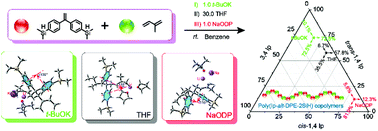Regulation of cis and trans microstructures of isoprene units in alternating copolymers via “space-limited” living species in anionic polymerization†
Abstract
Space-limited living species provide new insight into the regulation of the microstructure of isoprene units in alternating copolymers composed of isoprene (Ip) and 1,1-bis(4-dimethylsilylphenyl)ethylene (DPE-2SiH) using living anionic polymerization (LAP) modified with additives. It was found that suitable modifiers, such as sodium alkoxide (RONa), led to nearly 80% cis 1,4-addition of the isoprene units, while addition of potassium alkoxide (ROK) resulted in nearly 70% trans 1,4-addition. Through analysis, we know that the additives influence the angles between two subterminal benzene rings, and promote the regulatory effect of the space-limited living species on the cis and trans isoprene units. The larger the angle between two subterminal benzene rings, the more favourable are the conditions for addition polymerization in this form of microstructure. The copolymerization mechanism was investigated with the assistance of density functional theory (DFT) with Gaussian 09 and the corresponding characteristics of copolymers were determined with SEC, 1H NMR, 13C NMR and MALDI-TOF MS techniques. Due to the living features of LAP, this method can be employed as a key control of the copolymer chain sequence and microstructure at the same time.



 Please wait while we load your content...
Please wait while we load your content...